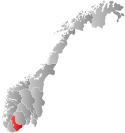Stokken
Stokken Municipality
Stokken herred | |
|---|---|
 View of the local Stokken Church | |
 Aust-Agder within Norway | |
 Stokken within Aust-Agder | |
| Coordinates: 58°29′30″N 08°50′38″E / 58.49167°N 8.84389°E | |
| Country | Norway |
| County | Aust-Agder |
| District | Østre Agder |
| Established | 1 July 1919 |
| • Preceded by | Austre Moland in 1919 |
| Disestablished | 1 Jan 1962 |
| • Succeeded by | Moland in 1962 |
| Administrative centre | Eydehavn |
| Area (upon dissolution)[1] | |
| • Total | 11 km2 (4 sq mi) |
| Population (1962) | |
| • Total | 2,783 |
| • Density | 250/km2 (660/sq mi) |
| Time zone | UTC+01:00 (CET) |
| • Summer (DST) | UTC+02:00 (CEST) |
| ISO 3166 code | NO-0917[2] |
Stokken is a former municipality in the old Aust-Agder county in Norway. The 11-square-kilometre (4.2 sq mi) municipality existed from 1919 until 1962 when it was merged into the newly-created Moland municipality. Today, the area is a part of the present-day municipality of Arendal in Agder county. The administrative centre of the municipality was the village of Eydehavn. The Stokken Church was the main church for the small municipality located just outside the town of Arendal.[1]
History
Stokken was historically a part of the municipality of Østre Moland since the establishment of that municipality on 1 January 1838 (see formannskapsdistrikt law). The municipality of Stokken was established on 1 July 1919 when the old municipality of Østre Moland was divided into two separate municipalities: Stokken (population: 1,683) and Austre Moland (population: 1,289).
During the 1960s, there were many municipal mergers across Norway due to the work of the Schei Committee. On 1 January 1962, the municipalities of Stokken (population: 2,783), Austre Moland (population: 1,607), Flosta (population: 1,205), as well as the Strengereid area of Tvedestrand (population: 375) were merged to create the new municipality of Moland. Then on 1 January 1992, the municipality of Moland (including the area of Stokken) was merged into the neighboring municipality of Arendal.[3]
Government
All municipalities in Norway, including Stokken, are responsible for primary education (through 10th grade), outpatient health services, senior citizen services, unemployment and other social services, zoning, economic development, and municipal roads. The municipality was governed by a municipal council of elected representatives, which in turn elected a mayor.[4]
Municipal council
The municipal council (Herredsstyre) of Stokken was made up of 19 representatives that were elected to four year terms. The party breakdown of the final municipal council was as follows:
| Party name (in Norwegian) | Number of representatives | |
|---|---|---|
| Labour Party (Arbeiderpartiet) | 15 | |
| Joint List(s) of Non-Socialist Parties (Borgerlige Felleslister) | 4 | |
| Total number of members: | 19 | |
| Party name (in Norwegian) | Number of representatives | |
|---|---|---|
| Labour Party (Arbeiderpartiet) | 14 | |
| Joint List(s) of Non-Socialist Parties (Borgerlige Felleslister) | 5 | |
| Total number of members: | 19 | |
| Party name (in Norwegian) | Number of representatives | |
|---|---|---|
| Labour Party (Arbeiderpartiet) | 12 | |
| Joint List(s) of Non-Socialist Parties (Borgerlige Felleslister) | 4 | |
| Total number of members: | 16 | |
| Party name (in Norwegian) | Number of representatives | |
|---|---|---|
| Labour Party (Arbeiderpartiet) | 11 | |
| Joint List(s) of Non-Socialist Parties (Borgerlige Felleslister) | 5 | |
| Total number of members: | 16 | |
| Party name (in Norwegian) | Number of representatives | |
|---|---|---|
| Labour Party (Arbeiderpartiet) | 13 | |
| Communist Party (Kommunistiske Parti) | 1 | |
| Joint List(s) of Non-Socialist Parties (Borgerlige Felleslister) | 2 | |
| Total number of members: | 16 | |
| Party name (in Norwegian) | Number of representatives | |
|---|---|---|
| Labour Party (Arbeiderpartiet) | 11 | |
| Joint List(s) of Non-Socialist Parties (Borgerlige Felleslister) | 5 | |
| Total number of members: | 16 | |
| Note: Due to the German occupation of Norway during World War II, no elections were held for new municipal councils until after the war ended in 1945. | ||
See also
References
- ^ a b Thorsnæs, Geir, ed. (24 June 2015). "Stokken". Store norske leksikon (in Norwegian). Kunnskapsforlaget. Retrieved 29 November 2017.
- ^ Bolstad, Erik; Thorsnæs, Geir, eds. (26 January 2023). "Kommunenummer". Store norske leksikon (in Norwegian). Kunnskapsforlaget.
- ^ Jukvam, Dag (1999). "Historisk oversikt over endringer i kommune- og fylkesinndelingen" (PDF) (in Norwegian). Statistisk sentralbyrå.
- ^ Hansen, Tore, ed. (12 May 2016). "kommunestyre". Store norske leksikon (in Norwegian). Kunnskapsforlaget. Retrieved 21 December 2020.
- ^ "Kommunevalgene og Ordførervalgene 1959" (PDF) (in Norwegian). Oslo: Statistisk sentralbyrå. 1960. Retrieved 21 December 2020.
- ^ "Kommunevalgene og Ordførervalgene 1955" (PDF) (in Norwegian). Oslo: Statistisk sentralbyrå. 1957. Retrieved 21 December 2020.
- ^ "Kommunevalgene og Ordførervalgene 1951" (PDF) (in Norwegian). Oslo: Statistisk sentralbyrå. 1952. Retrieved 21 December 2020.
- ^ "Kommunevalgene og Ordførervalgene 1947" (PDF) (in Norwegian). Oslo: Statistisk sentralbyrå. 1948. Retrieved 21 December 2020.
- ^ "Kommunevalgene og Ordførervalgene 1945" (PDF) (in Norwegian). Oslo: Statistisk sentralbyrå. 1947. Retrieved 21 December 2020.
- ^ "Kommunevalgene og Ordførervalgene 1937" (PDF) (in Norwegian). Oslo: Statistisk sentralbyrå. 1938. Retrieved 21 December 2020.
External links
 Arendal travel guide from Wikivoyage
Arendal travel guide from Wikivoyage

